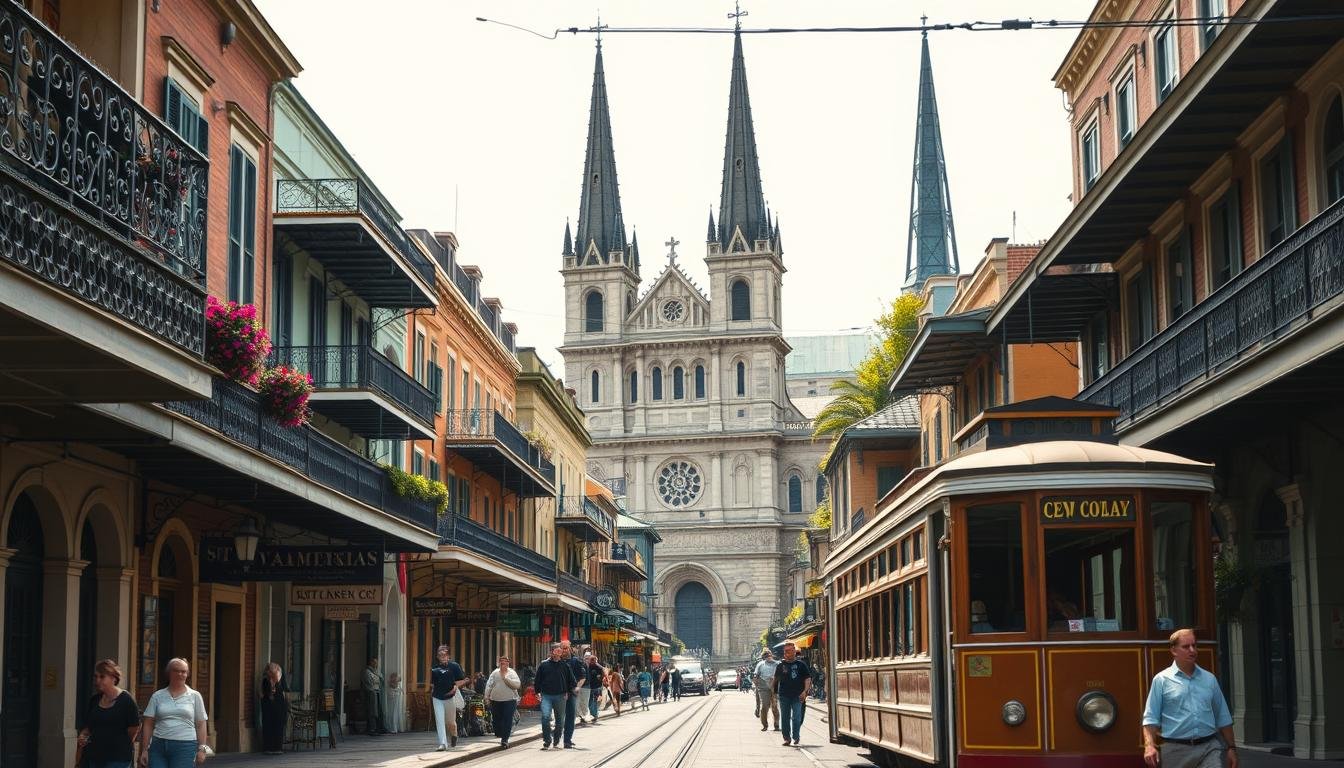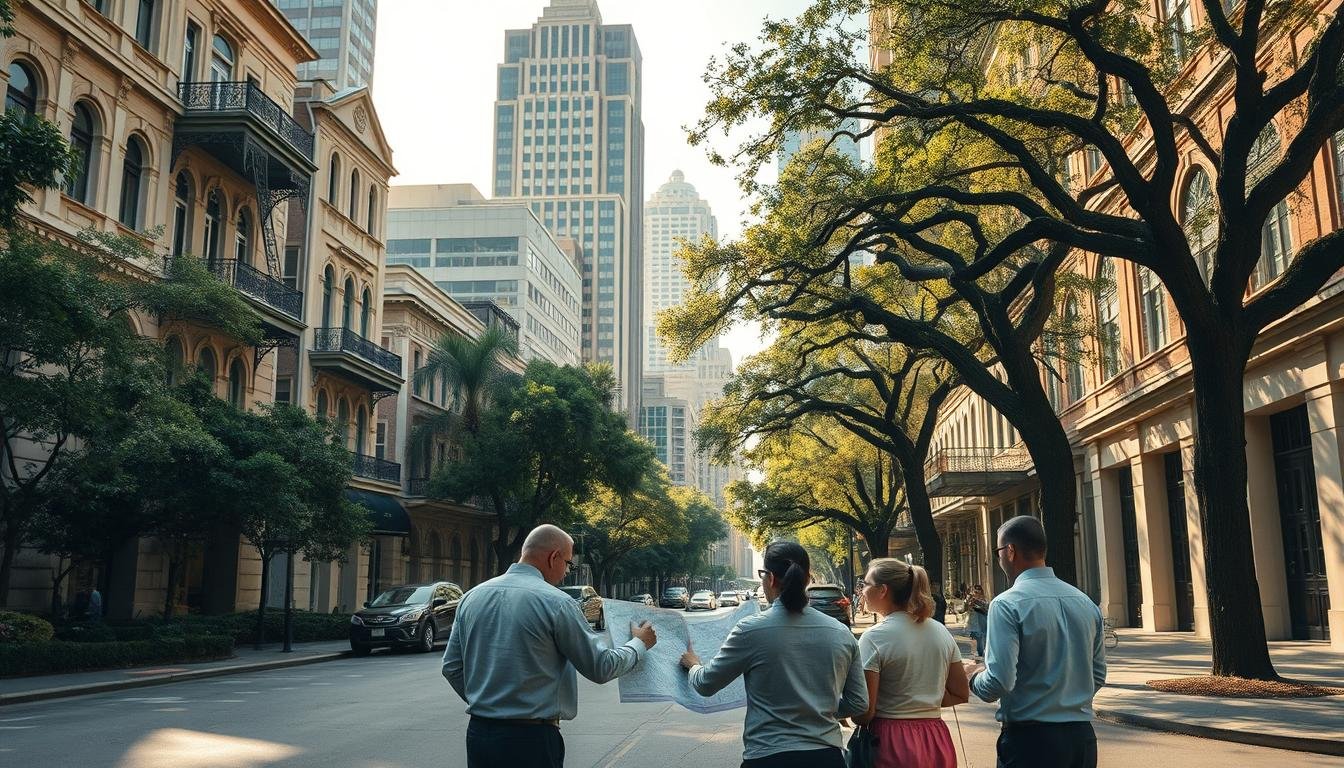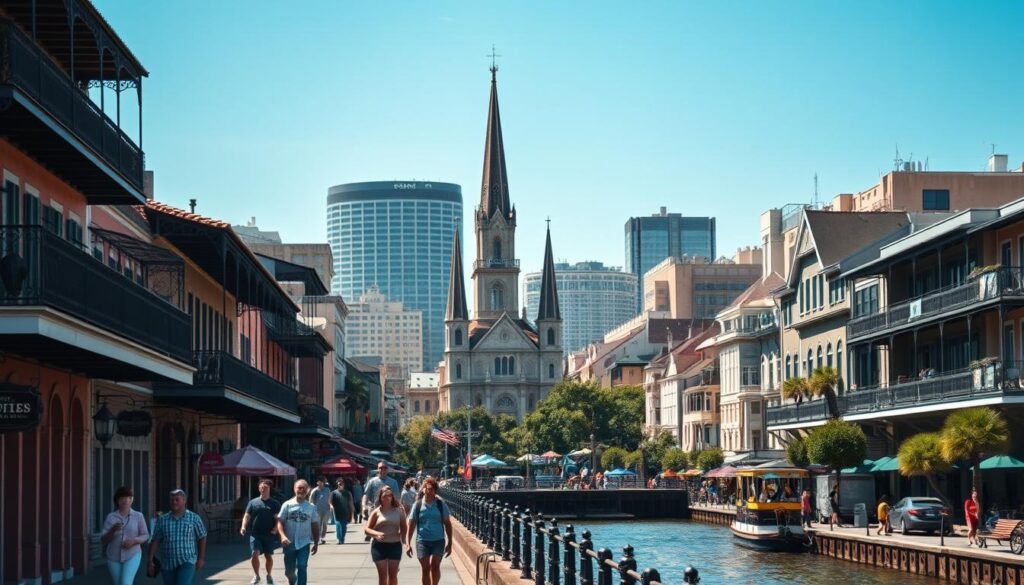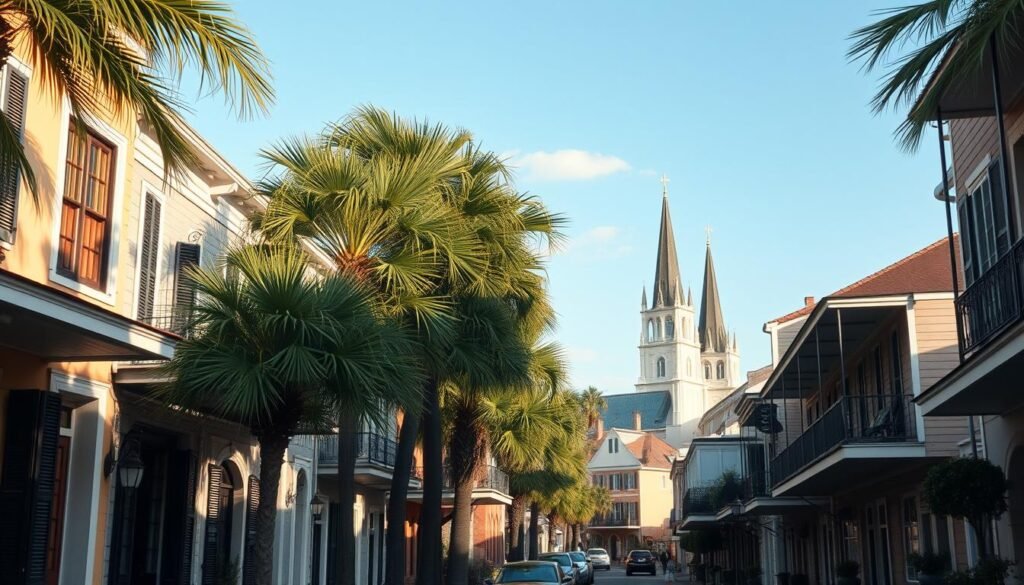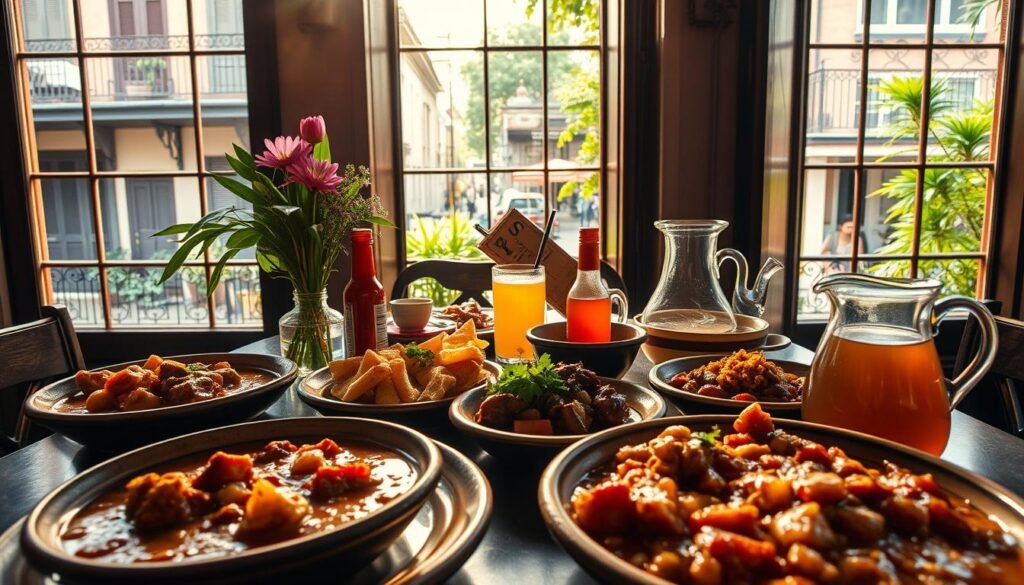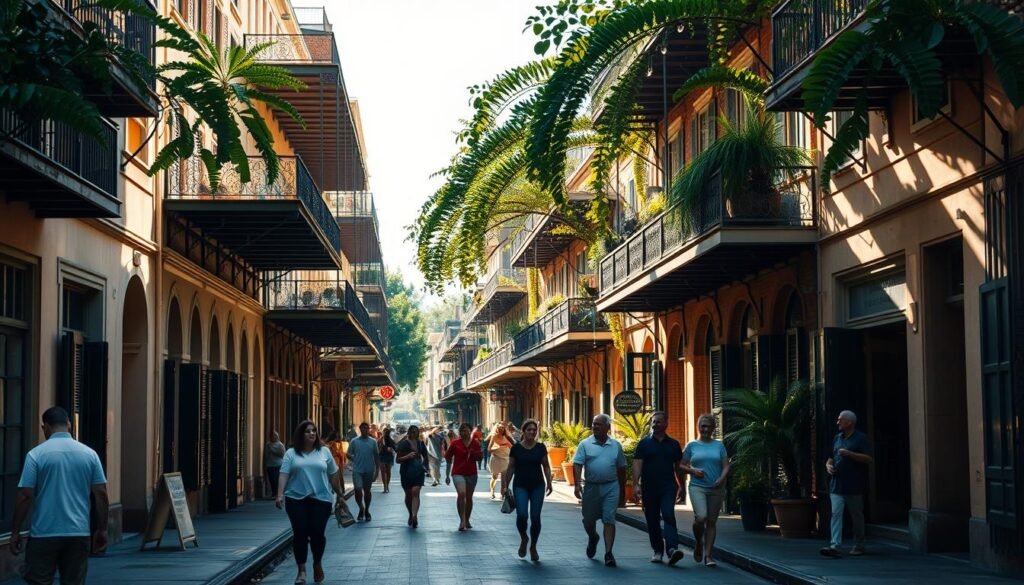Welcome to the vibrant French Quarter, where history, culture, and entertainment blend seamlessly. As a local, I’m excited to share my guide to the top attractions in this iconic neighborhood.
From historic landmarks to lively nightlife, the French Quarter has something for everyone. Let’s start our journey through the heart of the city, exploring the best things to do in this captivating area.
Key Takeaways
- Explore historic landmarks and cultural institutions
- Experience the vibrant nightlife
- Discover unique local cuisine
- Visit famous streets and squares
- Enjoy the local jazz and music scene
The Heart of New Orleans: The French Quarter
As the oldest neighborhood in New Orleans, the French Quarter is a treasure trove of history, architecture, and culture. It’s a place where the past and present blend seamlessly, creating a unique and captivating atmosphere.
History and Significance
The French Quarter’s history dates back to the early 18th century when it was founded by French colonists. Over the years, it has been influenced by various cultures, including Spanish and African, contributing to its rich heritage. This blend of cultures is evident in its architecture, cuisine, and cultural practices.
The area’s significance extends beyond its historical importance; it’s a living, breathing embodiment of New Orleans’ spirit. From the jazz music filling the air to the delicious Creole cuisine, every aspect of the French Quarter tells a story of the city’s past and present.
Architectural Wonders
The French Quarter is renowned for its stunning architecture, characterized by historic buildings, intricate ironwork, and picturesque balconies. The iconic Creole townhouses, with their vibrant colors and ornate details, are a testament to the area’s architectural heritage.
Walking through the French Quarter, you’ll discover a mix of French and Spanish colonial styles, reflecting the area’s complex history. The architectural wonders here are not just relics of the past but living, breathing parts of the city’s fabric.
Local Culture and Traditions
The French Quarter is a hub of cultural activity, with numerous festivals, live music venues, and traditional cuisine. The local culture is deeply rooted in the community, with many residents actively preserving and promoting the area’s heritage.
Jazz music, in particular, plays a significant role in the French Quarter’s cultural landscape. From impromptu street performances to renowned jazz clubs, the area is a paradise for music lovers. The blend of cultures and traditions is also reflected in the local cuisine, with popular dishes like gumbo and beignets being must-try experiences.
Must-See Landmarks in the French Quarter
From historic squares to architectural marvels, the French Quarter is dotted with landmarks that are a must-visit for anyone exploring New Orleans. As you stroll through the charming streets, you’ll discover a blend of history, culture, and entertainment that makes this neighborhood so unique.
Jackson Square
At the heart of the French Quarter lies Jackson Square, a historic park surrounded by iconic buildings, street performers, and local artists. This vibrant square is the perfect spot to soak up the atmosphere and take in the rich history of the area. Be sure to catch the lively street performers and browse the local artwork on display.
St. Louis Cathedral
Standing tall in Jackson Square is the stunning St. Louis Cathedral, a beautiful example of Gothic architecture in the heart of the city. This historic cathedral has been a beacon of faith and history for centuries, offering a serene escape from the bustling streets. Visitors can take a moment to appreciate the intricate details of the cathedral’s design and architecture.
Cabildo and Presbytère
Adjacent to St. Louis Cathedral are the Cabildo and Presbytère, two historic buildings that showcase the rich history and cultural heritage of the French Quarter. The Cabildo, once the site of the Louisiana State Legislature, now houses part of the Louisiana State Museum, while the Presbytère is home to the New Orleans Museum of Art’s collections. Explore the exhibits to gain a deeper understanding of the region’s history and culture.
These landmarks, among others, make the French Quarter a fascinating place to explore, offering a glimpse into the past while embracing the vibrant culture of New Orleans.
Discovering Bourbon Street
Bourbon Street is the heartbeat of New Orleans’ nightlife, pulsating with energy and excitement. As you step onto this iconic street, you’re immediately enveloped in a world where jazz melodies mingle with the hum of conversation and the clinking of glasses.
Known for its vibrant nightlife, Bourbon Street offers an array of experiences that cater to all tastes. From the sultry sounds of live jazz to the electrifying atmosphere of dance clubs, there’s something for everyone.
Nightlife and Entertainment
The nightlife on Bourbon Street is a spectacle like no other. As night falls, the street transforms into a dazzling display of neon lights, beckoning in revelers from around the world. It’s a place where the party never stops, and the energy is always electric.
Whether you’re in the mood for a laid-back evening of live music or an energetic night of dancing, Bourbon Street has it all. The street is lined with an assortment of bars, clubs, and lounges, each offering a unique experience.
Live Music Venues
Live music is at the heart of Bourbon Street’s nightlife. The street is home to some of the city’s most renowned music venues, where you can enjoy everything from jazz and blues to rock and pop.
Some of the most famous live music venues include Preservation Hall, known for its intimate performances of traditional New Orleans jazz, and the House of Blues, which hosts a variety of acts ranging from local talent to international superstars.
Famous Bars and Restaurants
No visit to Bourbon Street would be complete without stopping by some of its most famous bars and restaurants. From the historic Pat O’Brien’s, known for its dueling pianos and Hurricane cocktails, to the modern, trendy bars that line the street, there’s no shortage of places to grab a drink and enjoy the atmosphere.
For those looking to indulge in some of the city’s renowned cuisine, Bourbon Street offers a range of dining options. Whether you’re in the mood for classic Creole dishes or more contemporary fare, you’ll find it here.
| Venue | Type | Notable Feature |
|---|---|---|
| Preservation Hall | Live Music Venue | Intimate traditional New Orleans jazz performances |
| House of Blues | Live Music Venue | Hosts a variety of local and international acts |
| Pat O’Brien’s | Bar & Restaurant | Famous for dueling pianos and Hurricane cocktails |
Exploring Royal Street
As you wander through the French Quarter, Royal Street stands out as a haven for art lovers and collectors. This iconic street is renowned for its eclectic mix of art galleries, antique shops, and street performers, making it one of the top attractions in New Orleans French Quarter.
Royal Street is a visual feast, with its historic architecture providing a picturesque backdrop for the vibrant cultural scene. The street is lined with high-end art galleries showcasing local and international artists, alongside boutiques selling unique jewelry, clothing, and decorative items.
Art Galleries and Shops
The art galleries on Royal Street are a major draw, featuring a diverse range of works from contemporary pieces to classic masterworks. Visitors can explore galleries such as the George Schmidt Gallery and the Arthur Roger Gallery, which showcase an impressive selection of American and European art.
In addition to art galleries, Royal Street is home to a variety of specialty shops, including those selling handmade crafts, rare books, and bespoke jewelry. These unique stores offer something for everyone, whether you’re looking for a special souvenir or a unique gift.
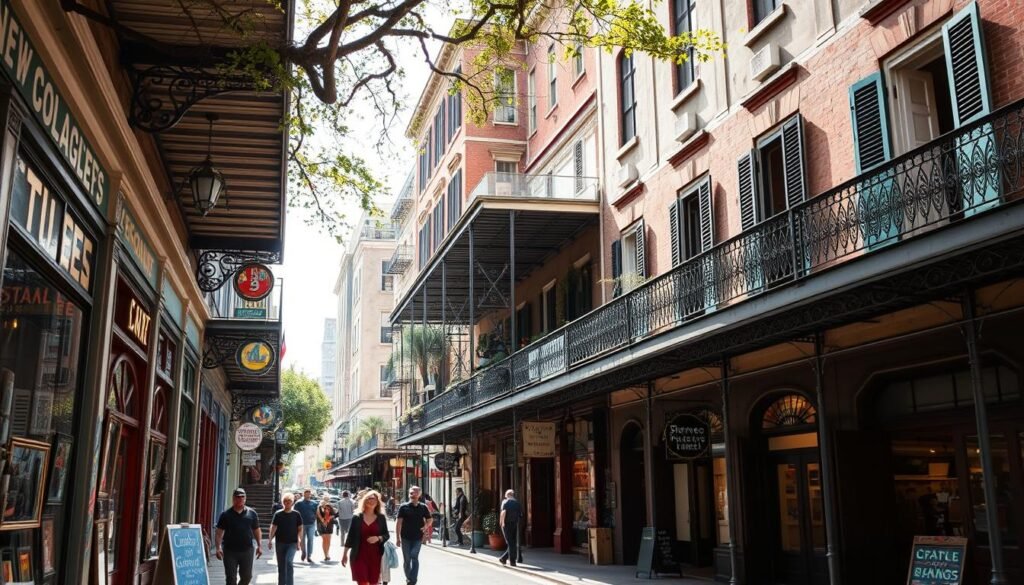
Antiques and Collectibles
Royal Street is also famous for its antique shops, which offer a vast array of collectibles and vintage items. From antique furniture to rare artifacts, these stores are a treasure hunter’s paradise. Visitors can discover one-of-a-kind pieces that reflect the rich history and culture of New Orleans.
Some of the antique shops on Royal Street have been in operation for decades, with owners who are passionate about preserving and sharing the city’s heritage. Whether you’re a seasoned collector or just browsing, the antique shops on Royal Street are sure to captivate and inspire.
Street Performers and Artists
No visit to Royal Street would be complete without experiencing the lively street performers and artists who add to the street’s dynamic atmosphere. From musicians to living statues, these performers entertain and engage passersby, creating an unforgettable experience.
The street performers on Royal Street are a testament to the city’s vibrant cultural scene, showcasing the creativity and talent that defines New Orleans. As you stroll down the street, be sure to stop and enjoy the shows, and perhaps even tip the performers for their entertaining acts.
In conclusion, Royal Street is a French Quarter must-see, offering a unique blend of art, history, and entertainment that reflects the essence of New Orleans. Whether you’re an art lover, a collector, or simply looking for a memorable experience, Royal Street is a destination that promises to delight and inspire.
French Market: A Culinary Delight
For a true taste of New Orleans, head to the French Market, where Creole cuisine and local culture come alive. As one of the best places to visit in French Quarter, it’s a must-visit destination for foodies and culture enthusiasts alike.
The French Market is a historic outdoor marketplace that has been in operation since the 18th century. It’s a vibrant hub where locals and visitors gather to experience the rich culinary heritage of New Orleans.
Local Food Stalls and Vendors
The French Market is renowned for its diverse array of local food stalls and vendors. From beignets and café au lait to Creole delicacies like gumbo and jambalaya, there’s something to satisfy every palate.
- Try a classic beignet at Cafe du Monde, a New Orleans institution.
- Sample Creole cuisine at one of the many food stalls.
- Enjoy fresh produce and local specialties.
Souvenirs and Crafts
Beyond the culinary delights, the French Market is also a great place to find unique souvenirs and local crafts. From handmade jewelry to decorative items, you’ll find something to remember your trip by.
| Souvenir Type | Description |
|---|---|
| Handmade Jewelry | Unique pieces reflecting New Orleans’ culture. |
| Local Artwork | Paintings and prints capturing the city’s spirit. |
| Culinary Spices | Blends and spices to recreate Creole dishes at home. |
Cooking Classes and Demonstrations
To deepen your understanding of Creole cuisine, the French Market offers cooking classes and demonstrations. Learn the secrets of traditional New Orleans dishes from experienced chefs.
Whether you’re a seasoned chef or a culinary novice, these classes are a great way to bring a taste of New Orleans back home.
Unique Museums in the French Quarter
The French Quarter boasts an array of fascinating museums that are sure to captivate anyone interested in history, culture, or the unusual. These cultural gems offer a deeper understanding of New Orleans’ rich heritage and are among the must-visit spots in New Orleans French Quarter.
The Voodoo Museum
Dedicated to the history and practice of voodoo, this museum is a fascinating, if not slightly eerie, experience. It houses a collection of voodoo artifacts, including ritual objects and gris-gris bags, providing a unique insight into this often-misunderstood aspect of New Orleans culture.
The Historic New Orleans Collection
For a more traditional historical experience, The Historic New Orleans Collection is a treasure trove of the city’s past. This museum features a range of exhibits, from historic photographs to detailed models of 19th-century New Orleans homes, offering a comprehensive look at the city’s development.
Audubon Butterfly Garden and Insectarium
A delightful surprise for visitors of all ages is the Audubon Butterfly Garden and Insectarium. This interactive museum features a stunning collection of butterflies and insects from around the world, as well as a Japanese garden and a playground, making it an ideal destination for families.
For those interested in exploring more of the French Quarter’s lesser-known museums, there are several other small, quirky museums worth visiting, each offering a unique perspective on the city’s culture and history.
| Museum | Focus | Highlights |
|---|---|---|
| The Voodoo Museum | Voodoo history and practice | Voodoo artifacts, gris-gris bags |
| The Historic New Orleans Collection | New Orleans history | Historic photographs, 19th-century home models |
| Audubon Butterfly Garden and Insectarium | Butterflies and insects | Global butterfly collection, Japanese garden |
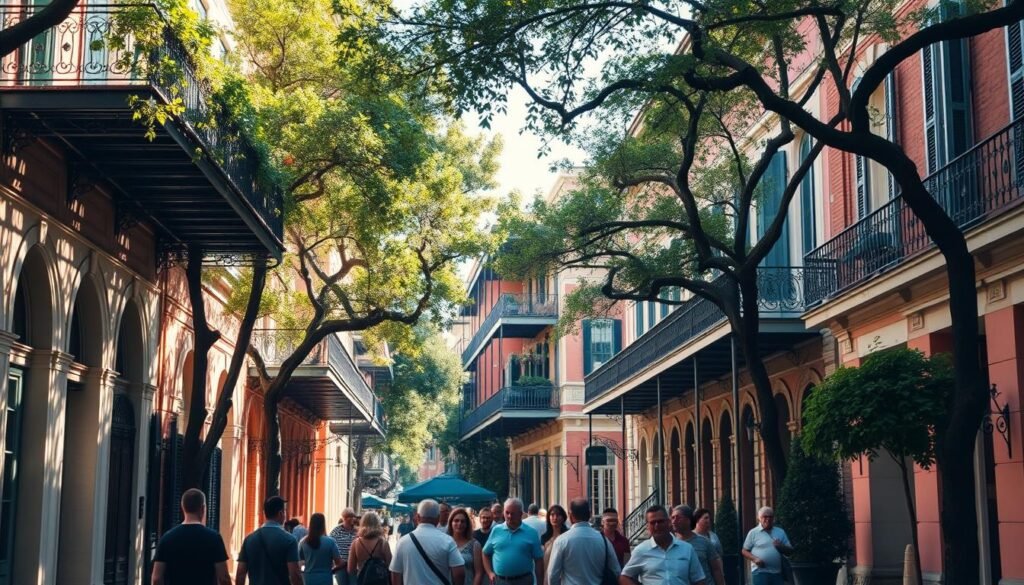
The Enigmatic Frenchmen Street
The French Quarter’s Frenchmen Street is where the city’s soulful jazz scene comes alive. This charming street offers a more intimate and laid-back atmosphere compared to the bustling Bourbon Street, making it a perfect spot for those seeking an authentic New Orleans experience.
Live Jazz and Music Scene
Frenchmen Street is renowned for its live jazz and music venues. You’ll find numerous clubs and bars featuring local musicians, creating an electrifying ambiance that’s quintessentially New Orleans. Some notable spots include:
- The Spotted Cat Music Club, known for its intimate setting and talented performers.
- Snug Harbor Jazz Bistro, offering a sophisticated atmosphere and exceptional jazz.
- Blue Nile, a popular venue with a diverse range of music and a lively crowd.
The street pulsates with the rhythm of jazz, making it a must-visit for music enthusiasts. As you stroll down Frenchmen Street, the melodies and improvisations fill the air, creating an unforgettable experience.
Trendy Bars and Cafés
In addition to its vibrant music scene, Frenchmen Street is home to a variety of trendy bars and cafés. These establishments offer a range of beverages and snacks, from craft cocktails to delicious Creole coffee. Some highlights include:
- Bar KonTiki, serving up creative cocktails in a stylish setting.
- Café Degas, a charming spot for coffee and people-watching.
- The Raven & The Spoon, offering a unique blend of food, drinks, and live music.
Whether you’re looking to relax with a coffee or enjoy a night out, Frenchmen Street’s bars and cafés have something for everyone.
Local Food Options
Frenchmen Street is also a culinary gem, with several local eateries serving up delicious Creole cuisine. Be sure to try:
- Willie Mae’s Scotch House, a beloved institution serving Southern comfort food.
- Jacques-Imo’s, a colorful café offering Creole and soul food.
- Elizabeth’s Restaurant, known for its breakfast dishes and Creole favorites.
The combination of live music, trendy bars, and local cuisine makes Frenchmen Street a holistic New Orleans experience.
As you explore Frenchmen Street, you’ll discover why it’s considered one of the top New Orleans French Quarter attractions. Its unique blend of music, culture, and cuisine makes it a standout destination in the French Quarter.
Annual Events and Festivals
The French Quarter is known for its vibrant annual events that bring the community together. These events are a reflection of the area’s rich history, cultural heritage, and joie de vivre.
Throughout the year, the French Quarter hosts a range of festivals that attract visitors from all over the world. Let’s dive into some of the most anticipated events.
Mardi Gras Celebrations
Mardi Gras is one of the most iconic events in New Orleans, and the French Quarter is at the heart of the celebrations. The streets come alive with parades, music, and colorful costumes.
During Mardi Gras, the French Quarter is filled with the sound of jazz and the sight of elaborate floats. It’s an experience unlike any other, with something for everyone to enjoy.
Jazz Fest Highlights
New Orleans Jazz & Heritage Festival, or Jazz Fest, is another major event that takes place in the French Quarter. This celebration of music, food, and culture is a must-visit for any music lover.
The festival features a diverse lineup of local and international artists, showcasing the best of jazz, blues, gospel, and more. With multiple stages and a lively atmosphere, Jazz Fest is an unforgettable experience.
Halloween Festivities
Halloween in the French Quarter is a unique and exciting experience. The area is known for its elaborate costumes, spooky decorations, and lively parties.
From haunted history tours to costume contests, there’s something for everyone during Halloween in the French Quarter. It’s a time when the area’s creative and eccentric sides shine.
| Event | Date | Description |
|---|---|---|
| Mardi Gras | Variable (usually February or March) | A colorful celebration with parades, music, and costumes. |
| Jazz Fest | Usually late April to early May | A festival celebrating music, food, and culture. |
| Halloween | October 31st | A spooky celebration with costumes, decorations, and parties. |
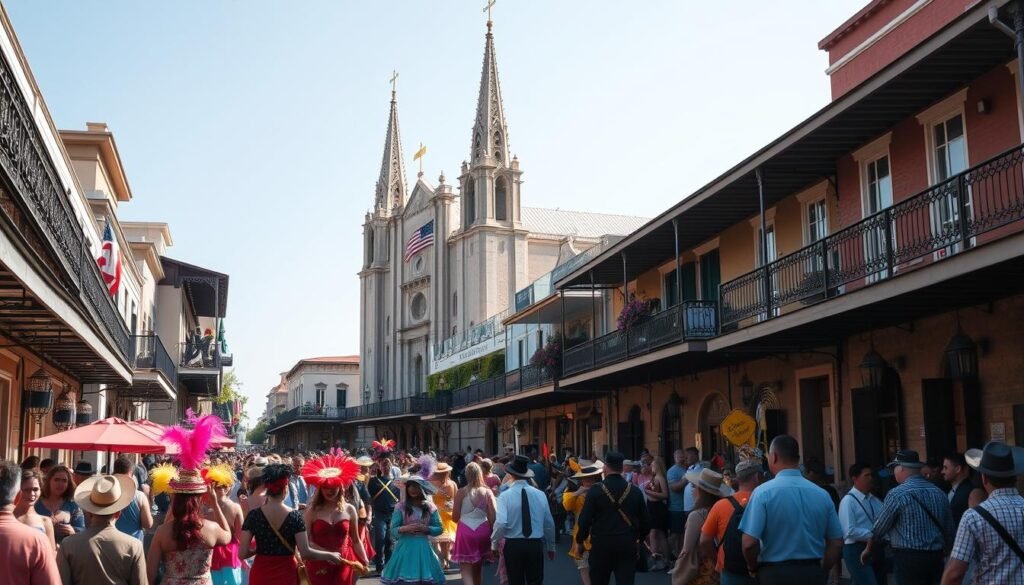
The French Quarter’s annual events are a testament to the area’s vibrant culture and community spirit. Whether you’re a local or just visiting, these events are not to be missed.
Shopping in the French Quarter
As you wander through the French Quarter, you’ll discover a treasure trove of shopping delights that reflect the area’s vibrant culture. The streets are lined with a diverse array of shops, from historic boutiques to modern art galleries, offering something for every taste and interest.
Artisanal Shops and Boutiques
The French Quarter is renowned for its artisanal shops and boutiques, where you can find everything from handmade jewelry to bespoke clothing. These unique stores offer a glimpse into the creative spirit of New Orleans, with many featuring local designers and artisans.
Some standout boutiques include Handmade on Royal, known for its artisanal goods, and Cadillac Street Boutique, which offers a curated selection of fashion and gifts.
Unique Souvenirs
Looking for a special memento of your trip? The French Quarter is filled with unique souvenir shops offering a range of items, from traditional New Orleans-themed gifts to more unusual collectibles.
Popular souvenir ideas include handmade crafts, local artwork, and Creole spices. You can also find a variety of unique items at New Orleans Historic Voodoo Museum’s gift shop, which offers a range of voodoo-themed souvenirs.
Local Craft Markets
For a truly local shopping experience, be sure to visit one of the French Quarter’s craft markets. These markets feature a range of local artisans and makers selling everything from handmade soaps to intricate woodcarvings.
| Market | Location | Notable Goods |
|---|---|---|
| French Market | 800 Decatur St | Coffee, spices, handmade crafts |
| Crescent City Farmers Market | 500 N. Peters St | Local produce, artisanal foods |
| New Orleans Jazz National Historical Park Market | 916 N. Peters St | Jazz-themed merchandise, local crafts |
Shopping in the French Quarter is not just about finding the perfect souvenir; it’s an experience that immerses you in the local culture. As one local shopkeeper noted,
“The French Quarter is a shopper’s paradise, with its rich history, vibrant culture, and endless creativity.”
Parks and Green Spaces
Amidst the vibrant energy of the French Quarter, serene parks and green spaces await discovery. These tranquil retreats offer a respite from the excitement and allow visitors to experience the softer side of New Orleans.
Louis Armstrong Park
Named after the legendary jazz musician, Louis Armstrong Park is a beautiful spot that celebrates the city’s rich musical heritage. The park is a great place to relax and enjoy the surroundings, with plenty of walking paths and scenic areas to explore.
Louis Armstrong Park is not just a green space; it’s a cultural hub that hosts various events and performances throughout the year, making it a must-visit for anyone interested in the local culture.
Woldenberg Park
Woldenberg Park is another gem in the French Quarter, offering stunning views of the Mississippi River. It’s an ideal spot for a leisurely stroll or a picnic with family and friends. The park also hosts various events and festivals, adding to its vibrant atmosphere.
The park’s riverfront location makes it a perfect spot to watch the riverboats cruise by, providing a unique perspective on the city’s iconic waterway.
Scenic Riverwalk
The Scenic Riverwalk is a great place to take a stroll, enjoying the sights and sounds of the river. This scenic path runs along the Mississippi River and offers beautiful views of the city skyline and the river traffic.
As you walk along the Riverwalk, you’ll have the opportunity to explore the various riverfront attractions and take in the city’s rich history and culture.
| Park/Attraction | Location | Highlights |
|---|---|---|
| Louis Armstrong Park | Between N. Rampart St. and Esplanade Ave. | Jazz performances, cultural events |
| Woldenberg Park | Along the Mississippi River | River views, public art installations |
| Scenic Riverwalk | Along the Mississippi River | River views, walking paths |
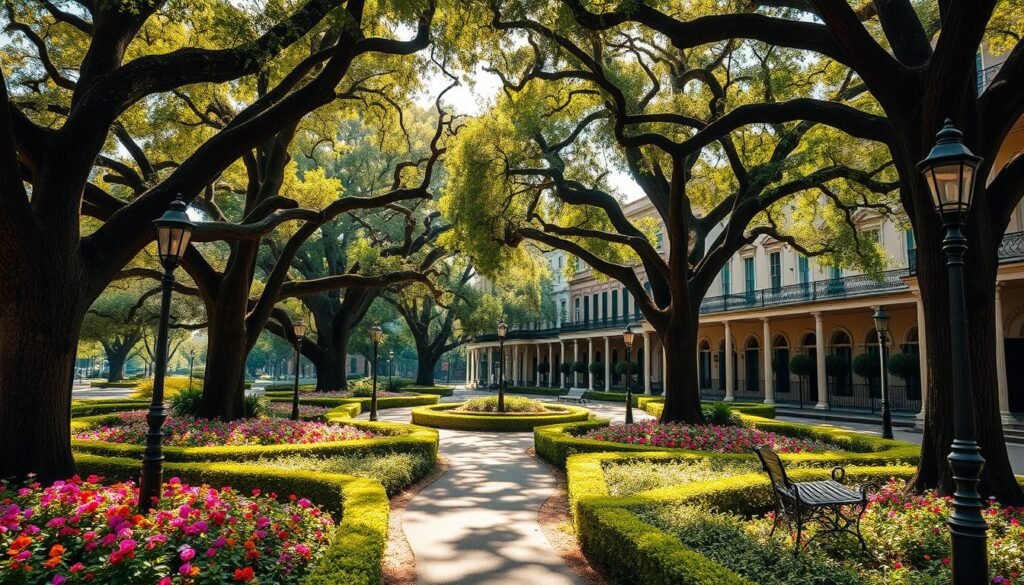
Tips for Visiting the French Quarter
As a local, I’m excited to share my insider knowledge on how to navigate the must-visit spots in New Orleans French Quarter like a pro. The French Quarter is a vibrant and historic area that requires some planning to fully appreciate.
Best Times to Visit
The best times to visit the French Quarter depend on your preferences. Spring and fall are great times to enjoy mild weather, with average highs in the mid-70s to mid-80s (°F). Summer can be hot and humid, but it’s the perfect time to experience the city’s many outdoor festivals. Winters are generally mild, making it a good time to explore indoor attractions like museums and galleries.
- Spring (March to May): Enjoy festivals like the New Orleans Jazz & Heritage Festival.
- Fall (September to November): Experience the city’s vibrant culture with events like the Voodoo Fest.
- Winter (December to February): Explore indoor attractions and enjoy holiday celebrations.
- Summer (June to August): Take part in outdoor festivals and enjoy the city’s nightlife.
Navigating the Area
Navigating the French Quarter is relatively easy, thanks to its grid-like street pattern. Many streets are pedestrian-friendly, making it a great area to explore on foot. You can also use the historic St. Charles Avenue streetcar to get around.
- Start at Jackson Square and explore the surrounding streets.
- Use a map or GPS to navigate the area, as street names can be confusing.
- Take breaks at one of the many local cafés or bars.
Safety Tips
As with any popular destination, it’s always a good idea to take some basic safety precautions when visiting the French Quarter. Here are a few tips to keep in mind:
- Be aware of your surroundings, especially at night.
- Keep valuables secure and consider using a hotel safe.
- Avoid walking alone in dimly lit or deserted areas.
- Stay hydrated and take breaks in shaded areas during hot weather.
By following these tips, you’ll be well on your way to having a safe and enjoyable visit to the French Quarter. Enjoy your time exploring this incredible part of New Orleans!
Culinary Adventures in the French Quarter
The French Quarter is a culinary paradise, offering a diverse range of Creole and Cajun cuisine that’s sure to tantalize your taste buds. As you explore the charming streets, be sure to indulge in some of the local flavors that make New Orleans famous.
Savoring Iconic Dishes
From beignets to gumbo, jambalaya to po’ boys, the French Quarter is home to a variety of iconic dishes that showcase the city’s rich culinary heritage. Be sure to try some of these local favorites at one of the many restaurants in the area, a perfect complement to the new orleans french quarter attractions you’ve experienced.
Popular Eats and Treats
Some of the most popular restaurants in the French Quarter include Cafe du Monde, known for its beignets and coffee, and Dooky Chase’s Restaurant, a legendary spot for gumbo and other Creole classics. Whether you’re in the mood for a hearty breakfast or a late-night snack, you’ll find plenty of options to satisfy your cravings.
Food Tours and Experiences
For a deeper dive into the local cuisine, consider taking a food tour or cooking class. These experiences allow you to sample a variety of dishes while learning about the history and culture behind them, making them one of the many things to do in french quarter new orleans that you won’t want to miss.
FAQ
What are the top attractions to visit in the New Orleans French Quarter?
The French Quarter is home to many iconic landmarks, including Jackson Square, St. Louis Cathedral, and Bourbon Street. You can also explore the French Market, visit the Voodoo Museum, or stroll along Royal Street to discover unique art galleries and antique shops.
What is the best time to visit the French Quarter?
The best time to visit the French Quarter depends on your preferences, but spring and fall are great times to enjoy mild weather. If you’re looking for a lively atmosphere, consider visiting during Mardi Gras or Jazz Fest.
How do I navigate the French Quarter?
The French Quarter is relatively easy to navigate on foot, with many streets being pedestrian-friendly. You can also use public transportation or ride-sharing services to get around.
What are some must-try dishes in the French Quarter?
The French Quarter is known for its Creole cuisine, so be sure to try iconic dishes like beignets, gumbo, and po’ boys. You can also sample local specialties like pralines and king cake.
Are there any safety tips I should keep in mind when visiting the French Quarter?
As with any popular destination, it’s always a good idea to take some basic safety precautions, such as staying aware of your surroundings and keeping valuables secure. Avoid walking alone in dimly lit areas at night, and stick to well-lit streets.
Can I take a guided tour of the French Quarter?
Yes, there are many guided tour options available, including walking tours, bus tours, and food tours. You can choose a tour that fits your interests and schedule.
What are some unique shopping experiences in the French Quarter?
The French Quarter is a shopper’s paradise, with a range of artisanal shops, boutiques, and local craft markets. You can find unique souvenirs, handmade jewelry, and local crafts.
Are there any parks or green spaces in the French Quarter?
Yes, there are several parks and green spaces in the French Quarter, including Louis Armstrong Park, Woldenberg Park, and the Scenic Riverwalk. These areas offer a peaceful respite from the hustle and bustle of the Quarter.
Can I visit the French Quarter during Mardi Gras?
Yes, the French Quarter is a hub of activity during Mardi Gras, with parades and celebrations taking over the streets. Be prepared for large crowds and plan ahead for accommodations and transportation.
What are some popular events and festivals in the French Quarter?
The French Quarter hosts a range of annual events and festivals, including Mardi Gras, Jazz Fest, and Halloween festivities. You can also find smaller events and celebrations throughout the year.
